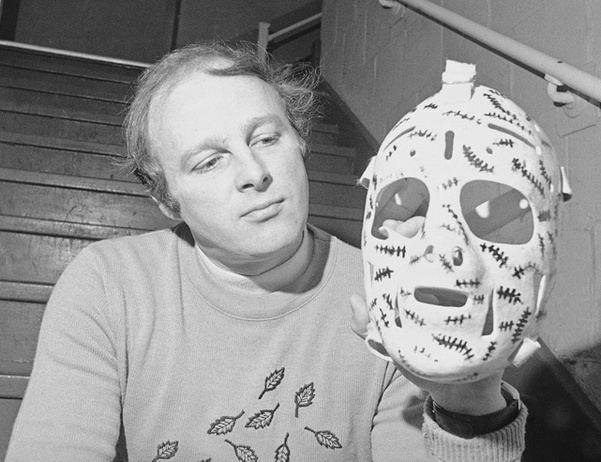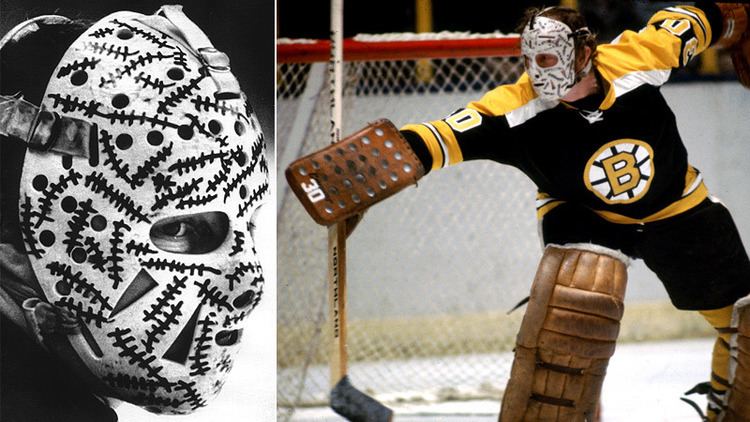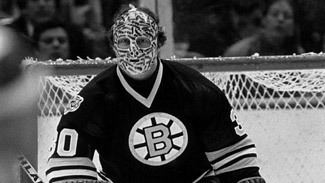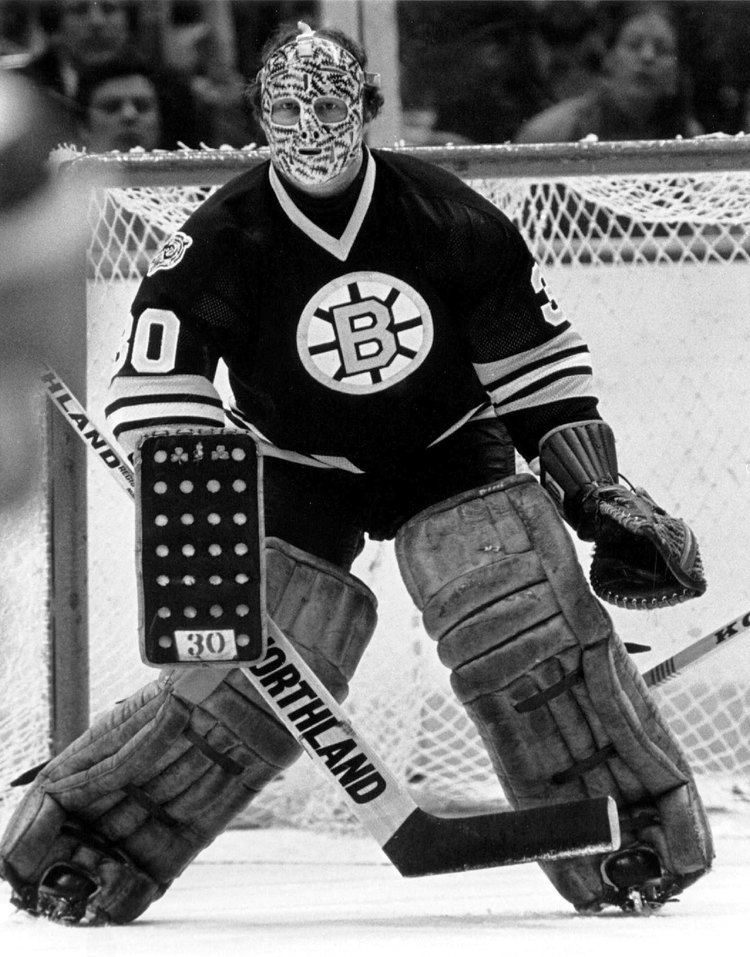Caught Left Role Ice hockey player Career end 1980 Name Gerry Cheevers Career start 1956 | Playing career Weight 82 kg Height 1.80 m Position Goaltender | |
 | ||
Born December 7, 1940 (age 84) St. Catharines, ON, CAN ( 1940-12-07 ) team NHLToronto Maple LeafsBoston BruinsWHACleveland CrusadersAHLPittsburgh HornetsRochester AmericansCHLOklahoma City BlazersEPHLSudbury WolvesSault Thunderbirds Similar People Zdeno Chara, Harry Sinden, Claude Julien | ||
Gerry Cheevers No. 30 Boston Bruins
Gerald Michael "Cheesey" Cheevers (born 7 December 1940 in St. Catharines, Ontario) is a former goaltender in the National Hockey League and World Hockey Association between 1961 and 1980, most famous for his two stints with the Boston Bruins, where he backstopped the team to Stanley Cup wins in 1970 and 1972. He was inducted into the Hockey Hall of Fame in 1985.
Contents
- Gerry Cheevers No 30 Boston Bruins
- Scariest nhl goalie mask gerry cheevers
- Playing career
- Style
- Mask
- Publications
- Coaching career
- Retirement
- Awards
- International play
- International
- References

Scariest nhl goalie mask gerry cheevers
Playing career

Cheevers' professional hockey career began in 1956 at the age of 16 when he played for the St. Michael's Majors of the Ontario Hockey Association.
He was owned by the Toronto Maple Leafs until the Boston Bruins drafted him in 1965. Cheevers still holds the American Hockey League single-season record for most victories by a goaltender. In 1965 he totaled 48 victories in leading the Rochester Americans to their first Calder Cup championship. He spent six years in all in the minors until, by 1967, he was Boston's number one goalie.

He was a member of both the 1970 and 1972 Stanley Cup winning teams, gaining a reputation as a driven, "money" goaltender.

In 1972, he went undefeated in 32 consecutive games, a NHL record that still stands.
In the fall of 1972, he jumped to the fledgling World Hockey Association, playing three and a half seasons for the Cleveland Crusaders as one of the league's best goalies, winning First Team All-Star honors in 1973 and Second Team honors in 1974 and 1975. In 1974 Gerry was the number one goaltender for Team Canada who played in seven of the eight games (of the 1974 Summit Series), only missing game three in order to attend the funeral of his father.
Returning to the Bruins during the 1976 season after financial disputes with Cleveland management, Cheevers formed a goalie tandem with Gilles Gilbert. Cheevers retired at the end of the 1980 season. Cheevers and Gilbert were runners-up for the Vezina in the 1979-80 season, which was won by Don Edwards and Bob Sauvé.
Cheevers had a career NHL goals against average of 2.89, recorded 230 NHL wins, played in 419 NHL games, and registered 26 NHL shutouts. He was also second in the WHA's history in career GAA and shutouts, despite playing in only half the league's seasons. Cheevers was inducted into the Hockey Hall of Fame in 1985, and is one of the few honoured goaltenders in the Hall to have never been named to the First or Second NHL All-Star Team nor won the Vezina Trophy.
Style
Cheevers was not afraid to stray from the crease both to cut down the shooter's angle and to act as a "third defenseman". He was very aggressive with opposing players who strayed into or near the crease. Many an opposing player who got too close to the goal crease got a quick smack from Cheevers' goal stick.
Not a "stand-up" goalie, Cheevers could often be found on his knees or even his side. He perfected this "flopping" style while playing for Rochester during the 1962–63 season. Americans' coach Rudy Migay had Cheevers practice without his stick, thus requiring him to rely more on using his body and his pads. From that point on Cheevers became one of hockey's best goaltenders.
Mask
Cheevers' iconic stitch-pattern goaltender mask came after a puck hit him in the face during practice. Cheevers, never one to miss an opportunity to skip out of practice, went to the dressing room. Bruins coach Harry Sinden followed him to the dressing room, where he found Cheevers enjoying a beer and smoking a cigarette. Annoyed, Sinden ordered Cheevers, who wasn't injured, to get back on the ice. In jest, John "Frosty" Forristall, the team trainer, drew a stitch mark on his mask, which amused the team. Ever after, any time he was similarly struck, he would have a new stitch-mark drawn on. Cheevers later claimed that the mask spared from requiring over 150 medical stitches over his career and was the first to be custom decorated in the sport. The mask became one of the most recognized of the era, and the original mask is now on the wall of his grandson's bedroom.
Years later, goalie Steve Shields would pay tribute to Cheevers when he played for the Bruins in 2002 and 2003, sporting a modern airbrushed version of the stitch-covered mask. In 2008, The Hockey News rated his mask the greatest ever with a wide margin. Cheevers received 221 of possible 300 points, while second-placed Gilles Gratton got 66.
Cheevers' mask design continued to live on in rock-n-roll culture. His mask was a big reason why Black Veil Brides' lead singer Andy Biersack got interested in hockey and played goalie when he was younger. As an ode to Cheevers' mask, Biersack used to paint stitches on his face for live shows.
Publications
In 1971, Cheevers published the book Goaltender, detailing his experiences during the previous season, through to the unexpected loss in the first round to the underdog Montreal Canadiens.
Coaching career
Cheevers' final season as a player came in 1980, when popular coach Don Cherry was replaced by Fred Creighton. After winning their division seven of the previous nine seasons, the Bruins were in third place late in the year, and general manager Harry Sinden fired Creighton, serving as interim coach for the remainder of the season himself. For the 1981 season, Cheevers was named as coach. Despite a shocking sweep in the 1981 playoffs to the Minnesota North Stars - the North Stars had never before won a game in Boston Garden in the fourteen years the team had been in the league - Sinden stuck with Cheevers, who led the Bruins to two first place and two second place finishes in their division, including to the league's best record in 1983, where the team fell only to the eventual Stanley Cup champion New York Islanders in the semifinals.
Cheevers was replaced by Sinden midseason two years later; his five years coaching the Bruins would be his only professional coaching stint. With a record of 204-126-46, he ranks 7th in career winning percentage (.604) for NHL coaches with more than 250 games experience.
Retirement
After his departure as Bruins' coach, Cheevers served as a color commentator for the Hartford Whalers from 1986 to 1995 and the Boston Bruins from 1999 to 2002. From 1995-2006 he was a member of the Bruins' scouting staff. Cheevers has also devoted his time to his interests in thoroughbred horse racing.
Awards
International play
International
"Gerry Cheever's stats". The Goaltender Home Page. Retrieved 2017-08-06.
